Birdfinding.info ⇒ Locally common on and around its remote mid-oceanic nesting islands, but rarely seen elsewhere. Some relatively accessible islands where it nests are in the Seychelles, Maldives, Réunion, and Mauritius. Nonbreeders can sometimes be found along the Kenyan coast and near Perth, Australia.
Lesser Noddy
Anous tenuirostris
Indian Ocean.
Breeding. Nests colonially on oceanic islets in the western and central Indian Ocean from the Seychelles and near-coastal islands of northern Madagascar east to the Maldives and Chagos Archipelago, and south to Réunion, Mauritius, and Rodrigues. Also in the far eastern Indian Ocean: on the Houtman Albrolhos Islands and Ashmore Reef (Australian territory southwest of Timor).
Nonbreeding. Partly resident around many of its nesting islands, but also disperses to other parts of the Indian Ocean. Ranges north across the Arabian Sea to the Gulf of Oman and around southern India and Sri Lanka, mainly from July to October.
Flocks are present along the East African coast from Somalia to Mozambique essentially year-round, but not known to breed there. Occasional as a vagrant south to South Africa, mainly December to March.
Identification
Similar to other members of the Black Noddy “complex,” but averages longer-billed, with more extensively pale-gray head and neck, including the lores—such that its eye usually stands out as a black spot mostly or completely surrounded by pale-gray.
Adults in fresh plumage appear mostly gray on the head and neck, and to a lesser degree on the rump and tail, with darker, blackish-brown wings and back. Its plumage turns browner with wear, and when heavily worn, it can appear almost entirely brown.
The gray on the head is typically paler on the crown and nape, and gradually transitions to darker shades around the mantle and the sides of the neck.
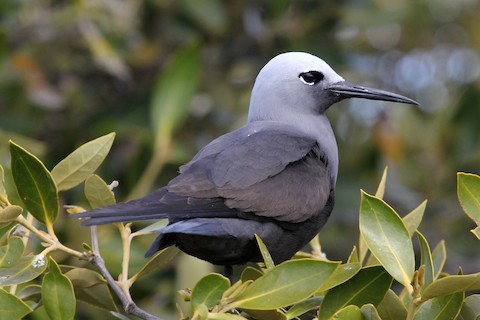
Lesser Noddy. (Wooded Island, Houtman Abrolhos Islands, Western Australia; October 13, 2017.) © Ray Turnbull
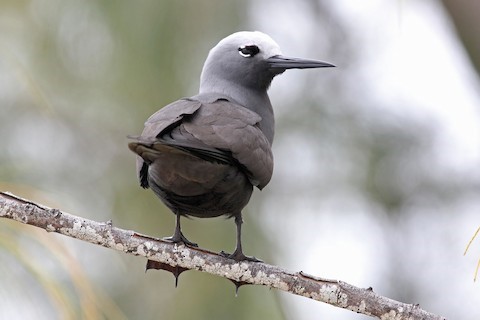
Lesser Noddy. (Île aux Cocos, Rodrigues Island, Mauritius; October 20, 2013.) © Phillip Edwards
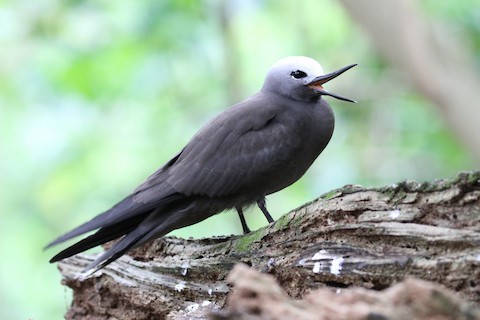
Lesser Noddy. (Aride, Seychelles; October 23, 2019.) © Oscar Campbell
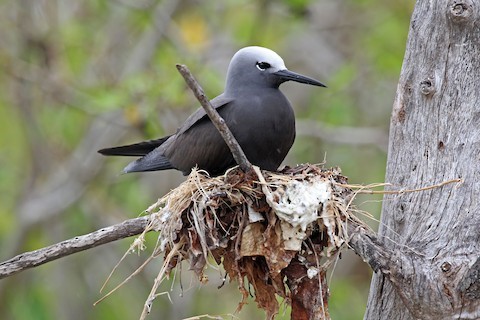
Lesser Noddy on nest. (Île aux Cocos, Rodrigues Island, Mauritius; October 20, 2013.) © Phillip Edwards
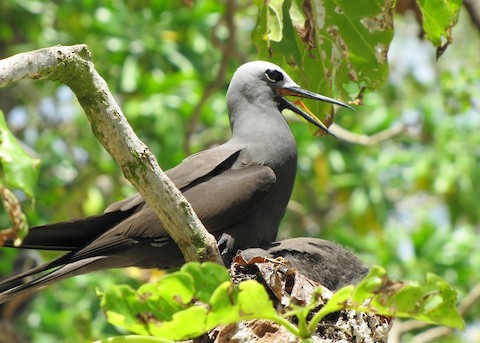
Lesser Noddy at nest. (Cousin Island, Seychelles; August 26, 2010.) © Mark Smiles

Lesser Noddy. (The Hidden Twin Beach, Kanyakumari, Tamil Nadu, India; August 12, 2018.) © Jose Jebaraj
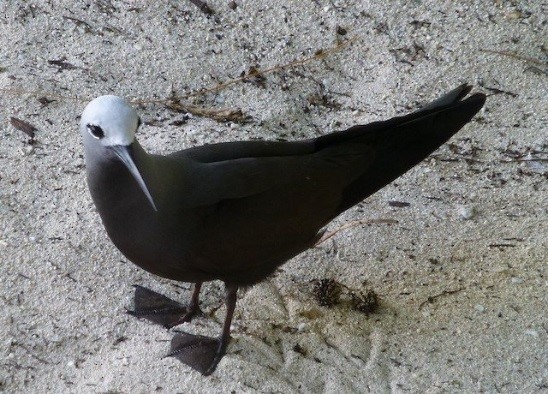
Lesser Noddy, appearing black overall and white-crowned in this lighting. (Cousin Island, Seychelles; July 1, 2013.) © Robin Duska Huff
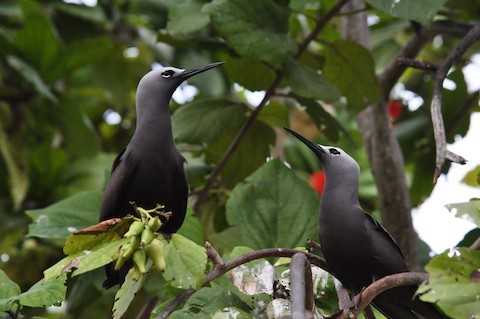
Lesser Noddy, pair. (Bird Island, Seychelles; April 5, 2018.) © Wouter Van Landuyt

Lesser Noddy, at nest. (Bird Island, Seychelles; April 23, 2018.) © Daniel Winzeler

Lesser Noddy, showing pale-gray lores. (West Island, Ashmore Reef, Western Australia; April 29, 2019.) © Magen Pettit
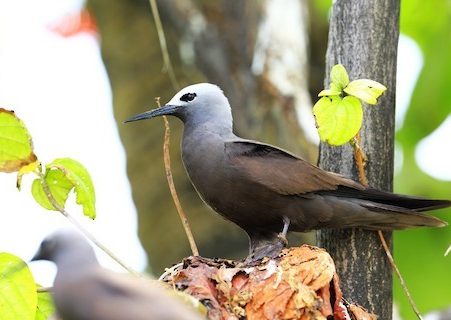
Lesser Noddy, appearing somewhat short-billed, white-headed, and brown-winged in this view. (Bird Island, Seychelles; October 1, 2013.) © Bird.soong
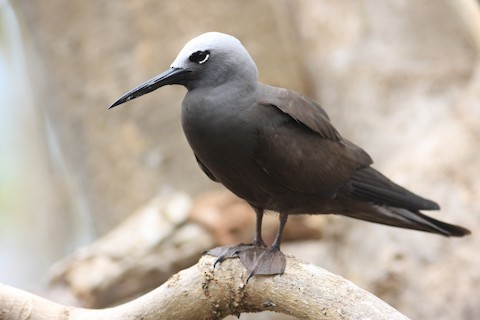
Lesser Noddy. (Aride, Seychelles; October 22, 2019.) © Oscar Campbell

Lesser Noddy. (Aride, Seychelles; October 22, 2019.) © Oscar Campbell
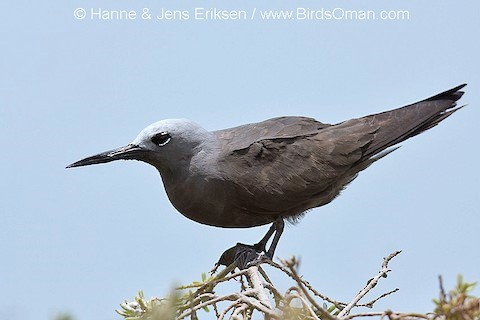
Lesser Noddy, showing an ashy-gray hood and blackish-brown wings and back. (Masirah Island, Ash Sharqiyah, Oman; August 8, 2008.) © Hanne & Jens Eriksen

Lesser Noddy, appearing mostly black or blackish in harsh sunlighty. (Aride, Seychelles; October 28, 2019.) © Steve James
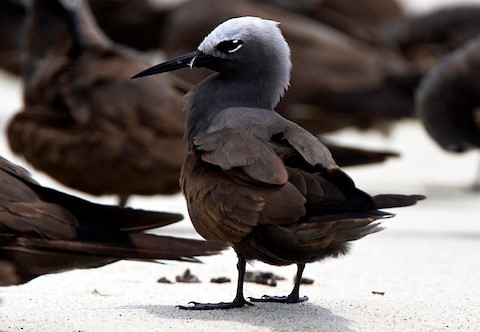
Lesser Noddy. (Wasini Island, Kenya; February 8, 2012.) © Marco Valentini
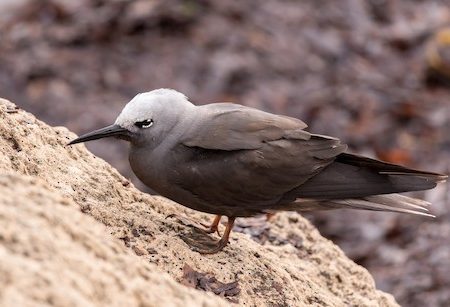
Lesser Noddy. (Woodman Point Regional Park, Cockburn, Western Australia; May 26, 2018.) © Kevin Horner
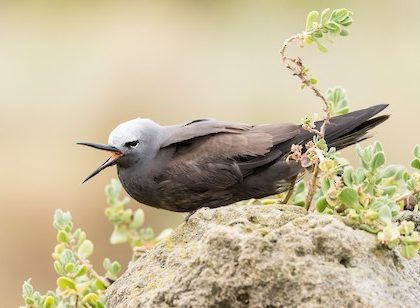
Lesser Noddy. (Woodman Point Regional Park, Cockburn, Western Australia; May 26, 2018.) © Kevin Horner
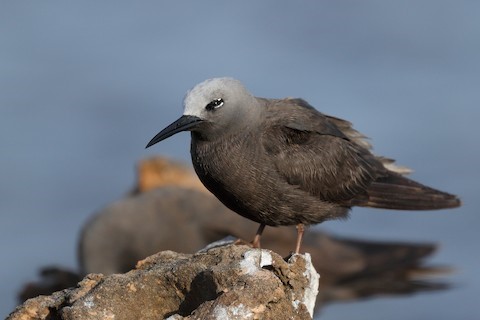
Lesser Noddy, appearing somewhat thick-billed and pale-legged, but showing diagnostically pale lores. (Quobba Station, Carnarvon, Western Australia; April 6, 2018.) © Leslie George
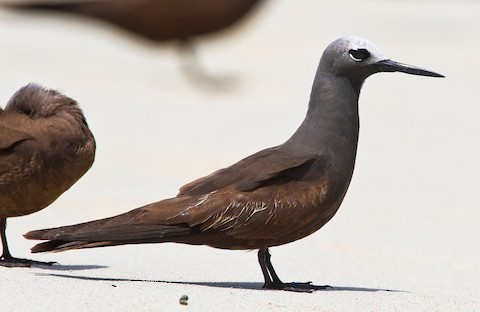
Lesser Noddy, likely an immature based on its crown coloration and pattern. (Wasini Island, Kenya; February 8, 2012.) © Marco Valentini
Immatures resemble adults, but typically with a shorter bill and a whitish crown that is somewhat uneven and contrasts (instead of blending) with otherwise blackish plumage.

Lesser Noddy, immature with crown whitening. (Pulicat Lake, Thiruvallur, Tamil Nadu, India; June 15, 2018.) © Harish Thangaraj

Lesser Noddy, in worn plumage, appearing exceptionally pale-brown overall, likely a juvenile based on its crown pattern. (Pulicat Lake, Thiruvallur, Tamil Nadu, India; May 1, 2018.) © Renuka Vijayaraghavan

Lesser Noddy, likely a juvenile based on its crown pattern. (Pulicat Lake, Thiruvallur, Tamil Nadu, India; May 1, 2018.) © Vikas Madhav Nagarajan

Lesser Noddy. (Île aux Cocos, Rodrigues Island, Mauritius; October 20, 2013.) © Phillip Edwards
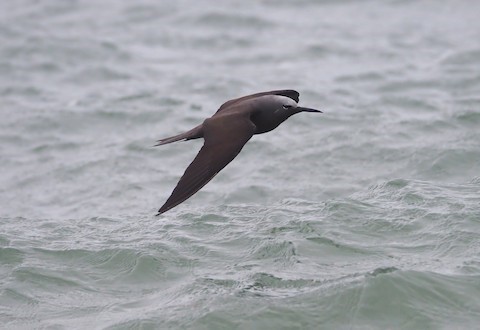
Lesser Noddy. (Woodman Point Regional Park, Cockburn, Western Australia; May 25, 2020.) © John Baas

Lesser Noddy. (Aride, Seychelles; October 28, 2019.) © Steve James
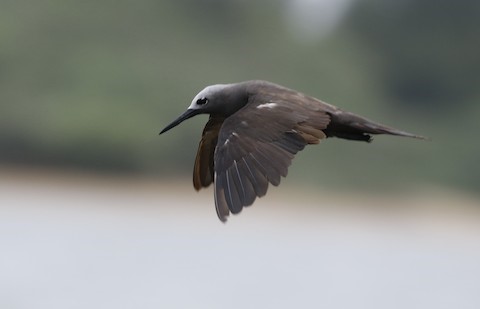
Lesser Noddy. (Pulicat Lake, Thiruvallur, Tamil Nadu, India; September 1, 2018.) © Vijaya Lakshmi
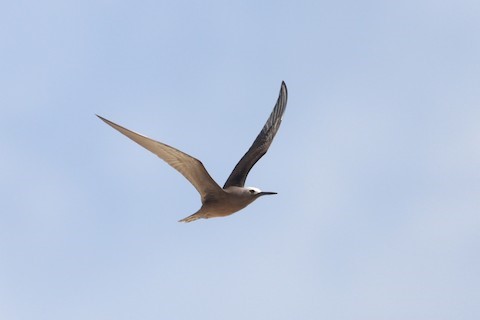
Lesser Noddy. (Cousin Island, Seychelles; October 23, 2012.) © Oscar Campbell
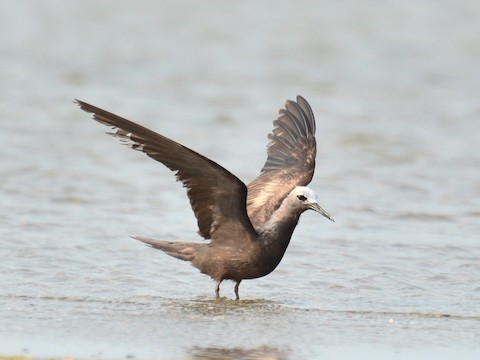
Lesser Noddy. (Pulicat Lake, Thiruvallur, Tamil Nadu, India; April 30, 2018.) © Renuka Vijayaraghavan

Lesser Noddy. (Aride, Seychelles; October 28, 2019.) © Steve James
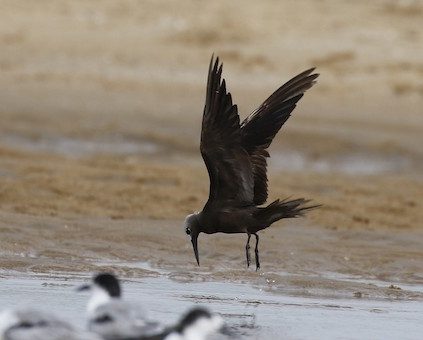
Lesser Noddy. (Pulicat Lake, Thiruvallur, Tamil Nadu, India; July 18, 2018.) © Vijaya Lakshmi
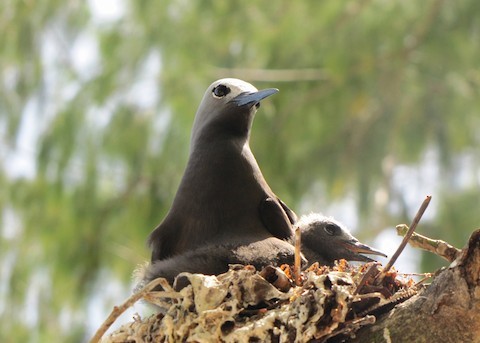
Lesser Noddy. (Cousin Island, Seychelles; August 26, 2010.) © Mark Smiles
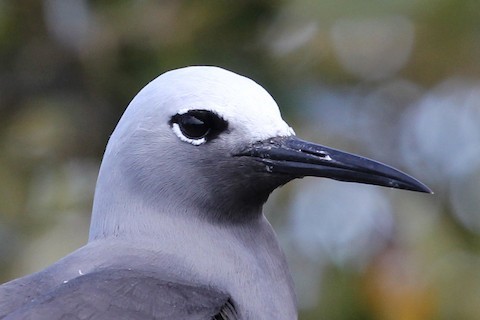
Lesser Noddy, with head and neck appearing mostly pale-gray, surrounding black orbital area. (Wooded Island, Houtman Abrolhos Islands, Western Australia; October 13, 2017.) © Ray Turnbull
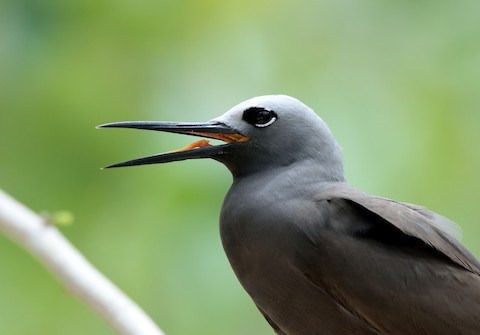
Lesser Noddy. (Cousin Island, Seychelles; October 20, 2016.) © Ori Davidor
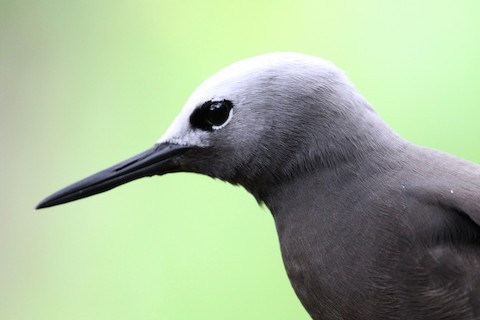
Lesser Noddy, close-up showing facial pattern. (Aride, Seychelles; October 23, 2019.) © Oscar Campbell
Cf. “Pacific Black” and “Atlantic Black” Noddies. The Lesser Noddy was traditionally considered a subspecies of Black Noddy, but it is widely recognized as a separate species. Lesser has distinctive features that differentiate it from the “Pacific Black Noddies” that occur with it in the eastern Indian Ocean, and from the “Atlantic Black Noddy”, which could potentially occur in South African waters. Lesser typically has a longer bill and more extensive gray on the head and neck. In particular, Lesser has pale lores—noticeable at a distance as Lesser’s eye appears as an isolated dark patch on a mostly pale face.

Lesser Noddy, showing pale-gray lores. (West Island, Ashmore Reef, Western Australia; April 29, 2019.) © Magen Pettit
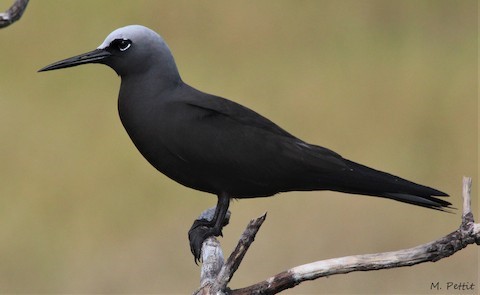
“Pacific Black Noddy,” A. m. minutus, showing black lores. (West Island, Ashmore Reef, Western Australia; April 29, 2019.) © Magen Pettit
Cf. “Hawaiian Noddy”. The ranges of “Hawaiian” and Lesser Noddies are far enough removed from one another that there is little potential for overlap. However, either of them could stray and if encountered in neutral territory out of their usual contexts they could easily be mistaken for one another.
Lesser has a proportionately longer bill than “Hawaiian”, and its feet are usually blackish whereas “Hawaiian’s” are usually some shade of orange. The two have similar head coloration but slightly different patterns, as Lesser typically has pale lores—which are noticeable at a distance as Lesser’s eye appears as an isolated dark patch on a mostly pale face.
“Hawaiian’s” rump and tail typically appear pale-gray (often whitish), whereas Lesser’s rump and tail typically appear black or blackish-brown. However, this feature, while distinctive on most “Hawaiians”, is somewhat inconsistent so some individuals may be intermediate.
Notes
Polytypic species consisting of two recognized subspecies.
Traditionally considered conspecific with other members of the Black Noddy complex, “Atlantic Black” (atlanticus), “Pacific Black” (minutus), and “Hawaiian” (melanogenys), known collectively as the Black Noddy (A. tenuirostris). Taxonomists increasingly recognize multiple species in this group. In particular, Lesser (a.k.a. “Indian Black”; tenuirostris) is visually distinctive and apparently breeds alongside “Pacific Black Noddy” at Ashmore Reef without interbreeding—if so, this effectively proves that they are separate species.
Howell and Zufelt (2019) recognize each of the four forms as separate species. In addition to Lesser, it seems appropriate to classify “Hawaiian” as separate based on factors that include pronounced differences in plumage, leg color, and bill length, and their persistence as recognizably distinct despite overlapping ranges.
Assuming that both Lesser and “Hawaiian” are ultimately recognized as separate species, biogeographic logic would tend to imply that the other two forms, “Atlantic Black” and “Pacific Black”, should be presumptively separate as well—although they are very similar and might not be reliably distinguishable.
References
BirdLife International. 2018. Anous tenuirostris. The IUCN Red List of Threatened Species 2018: e.T22694805A132575736. https://dx.doi.org/10.2305/IUCN.UK.2018-2.RLTS.T22694805A132575736.en. (Accessed December 16, 2020.)
eBird. 2020. eBird: An online database of bird distribution and abundance. Cornell Lab of Ornithology, Ithaca, N.Y. http://www.ebird.org. (Accessed December 16, 2020.)
Harrison, P. 1983. Seabirds: An Identification Guide. Houghton Mifflin, Boston.
Howell, S.N.G., and K. Zufelt. 2019. Oceanic Birds of the World. Princeton University Press.
Sinclair, I., P. Hockey, W. Tarboton, and P. Ryan. 2011. Birds of Southern Africa (Fourth Edition). Random House Struik (Pty) Ltd. Cape Town, South Africa.
Xeno-Canto. 2020. Lesser Noddy – Anous tenuirostris. https://www.xeno-canto.org/species/Anous-tenuirostris. (Accessed December 16, 2020.)

